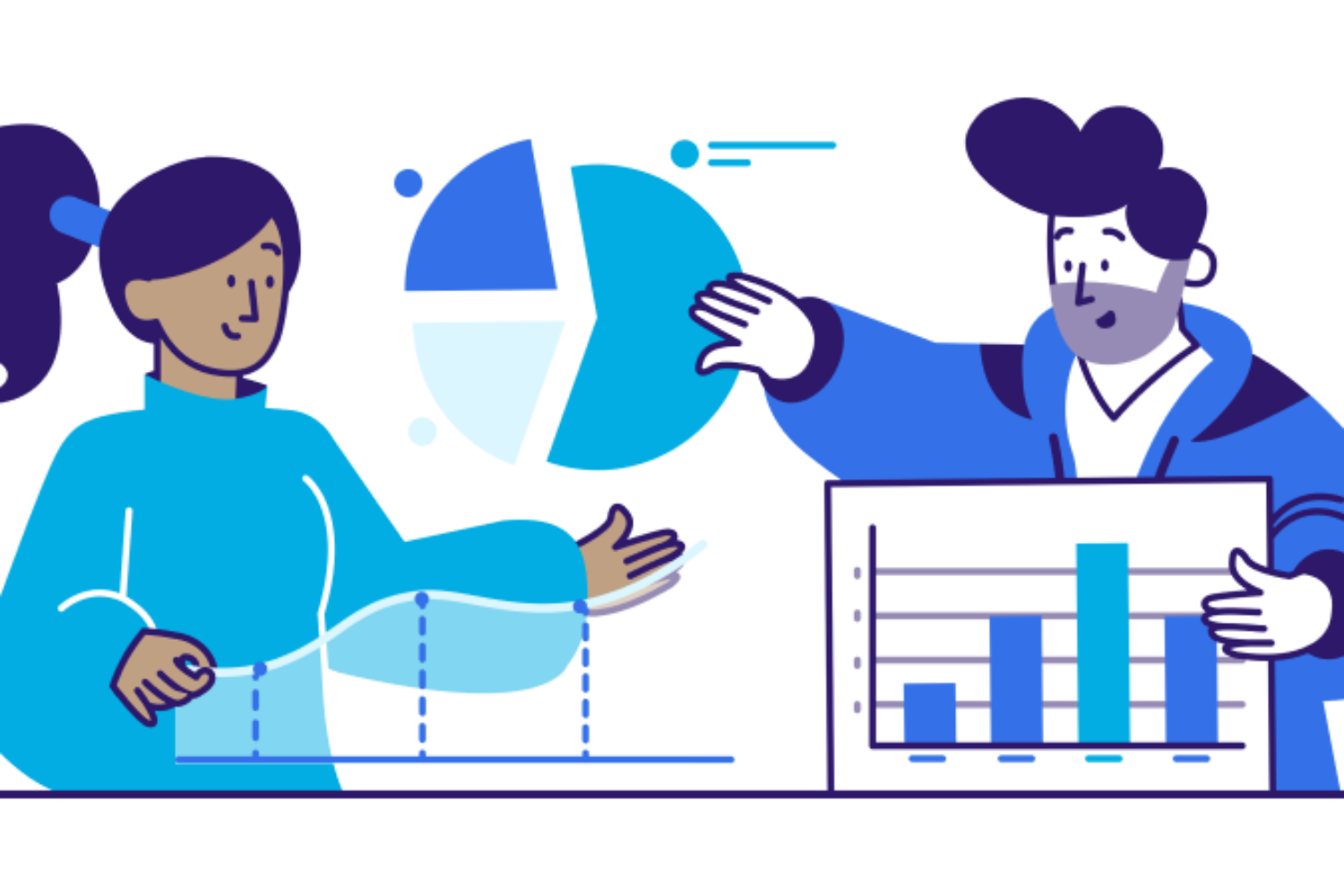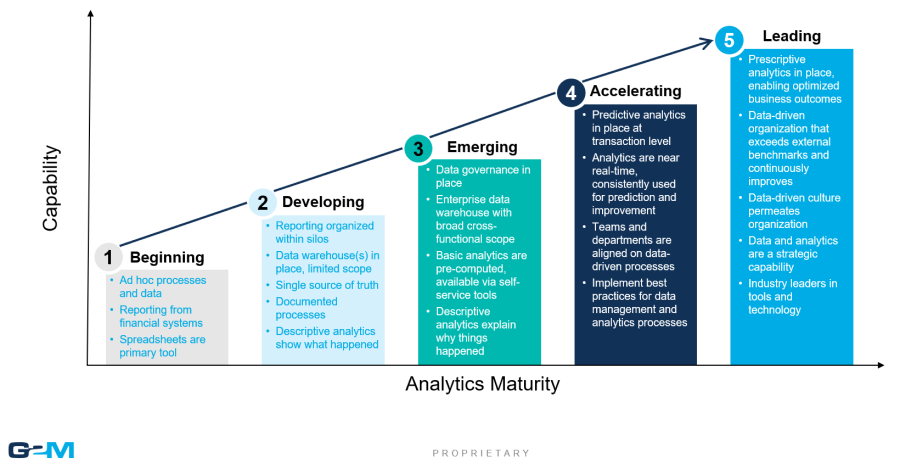For sales and marketing executives, the ability to harness data effectively is the difference between guesswork and strategic decision-making. Yet, many organizations struggle to assess their analytics maturity and chart a course for improvement. G2M Insights’ business analytics maturity model provides a structured framework to help organizations evaluate their current state and build the necessary capabilities to optimize business outcomes.
In this post, we share our five-level maturity model that defines the progression from ad hoc reporting to a fully data-driven organization. We then explore each stage in depth, identifying key capabilities, processes, and technologies that mark the transition from one level to the next.
The Five Levels of Analytics Maturity
1. Beginning: Ad Hoc Analytics
Organizations at this stage rely on spreadsheets and isolated reporting tools, with minimal integration or strategic use of data. Decisions are largely intuitive, and there is limited visibility into performance.
2. Developing: Basic Analytics
At this level, reporting begins to take shape, often within functional silos. Companies establish financial reporting packages, but data quality and consistency issues persist. Descriptive analytics provide insights into past performance.
3. Emerging: Advanced Descriptive & Early Predictive Analytics
Organizations develop a centralized data warehouse and establish governance processes. Self-service tools become available, and some predictive analytics capabilities emerge, allowing businesses to anticipate trends rather than just react.
4. Accelerating: Predictive & Prescriptive Analytics
Analytics becomes ingrained in decision-making across the organization. Predictive analytics drive business strategy, and real-time insights enable proactive interventions. Teams align around data-driven processes.
5. Leading: Optimized, AI-Driven Decision Making
At this stage, organizations leverage advanced machine learning, AI, and prescriptive analytics to optimize outcomes. A data-driven culture permeates every aspect of the business, driving continuous improvement and industry leadership.
Deep Dive: Analytics Maturity by Stage
1. Beginning Stage
-
- Data Management & Governance: No governance, fragmented data.
- Reporting & Dashboarding: Static reports, ad hoc reporting.
- Predictive & Prescriptive Analytics: No predictive capabilities.
- Sales & Marketing Analytics Integration: Siloed departments, disconnected data.
- Decision-Making Culture: Intuition-driven decisions.
- Common Issues: Lack of visibility, inconsistent data, manual effort.
2. Developing Stage
-
- Data Management & Governance: Initial consolidation within departments.
- Reporting & Dashboarding: Standardized but siloed reporting.
- Predictive & Prescriptive Analytics: Basic statistical analysis.
- Sales & Marketing Analytics Integration: Some linkage between financial and operational data.
- Decision-Making Culture: Limited use of data-driven insights.
- Common Issues: Data inconsistencies, low adoption of analytics tools.
3. Emerging Stage
-
- Data Management & Governance: Enterprise governance frameworks established.
- Reporting & Dashboarding: Interactive dashboards provide visibility.
- Predictive & Prescriptive Analytics: Predictive models begin influencing decisions.
- Sales & Marketing Analytics Integration: Single source of truth established.
- Decision-Making Culture: Data influences key decisions.
- Common Issues: Gaps in predictive capabilities, limited automation.
4. Accelerating Stage
-
- Data Management & Governance: High-quality, managed data.
- Reporting & Dashboarding: Real-time reporting and analytics.
- Predictive & Prescriptive Analytics: Machine learning models optimize processes.
- Sales & Marketing Analytics Integration: Cross-functional alignment.
- Decision-Making Culture: Data is embedded into daily decision-making.
- Common Issues: Scaling predictive models, integrating AI-driven insights.
5. Leading Stage
-
- Data Management & Governance: Seamless, master data management.
- Reporting & Dashboarding: AI-driven, prescriptive insights.
- Predictive & Prescriptive Analytics: Fully automated AI-driven decision-making.
- Sales & Marketing Analytics Integration: Optimized, predictive engagement strategies.
- Decision-Making Culture: Fully data-driven enterprise.
- Common Issues: Managing complexity, ensuring continuous optimization.
Moving Up the Maturity Curve: Next Steps
For organizations seeking to enhance their analytics maturity, the following steps can accelerate progress:
-
- Assess Current Maturity – Identify where your organization falls within the maturity model.
- Define a Roadmap – Establish clear objectives for moving to the next stage.
- Invest in Data Infrastructure – Ensure high-quality data, governance, and integration across functions.
- Build Analytical Capabilities – Deploy predictive analytics tools and invest in AI-driven insights.
- Foster a Data-Driven Culture – Align leadership and teams around data-driven decision-making.
By systematically improving capabilities in each area, companies can unlock the full potential of analytics and gain a competitive edge in their industry.
Conclusion
The G2M business analytics maturity model provides a structured pathway for sales and marketing executives to assess and enhance their organization’s analytical capabilities. By understanding where they currently stand and taking targeted actions to progress, organizations can transition from reactive decision-making to a data-driven, AI-powered enterprise.
For those looking to accelerate their journey, G2M Insights offers expert guidance in assessing and advancing analytics maturity. Contact us today to begin your transformation into a data-driven leader.
How Can We Help?
Feel free to check us out and start your free trial at https://app.g2m.ai or contact us below!


